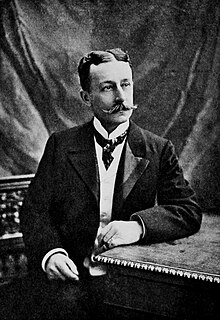You can help expand this article with text translated from the corresponding article in French. (June 2018) Click for important translation instructions.
|
| René Bazin | |
|---|---|
 Bazin portrait, c. 1905 Bazin portrait, c. 1905 | |
| Born | René François Nicolas Marie Bazin (1853-12-26)26 December 1853 Angers, France |
| Died | 20 July 1932(1932-07-20) (aged 78) Paris, France |
| Pen name | Bernard Seigny |
| Nationality | French |
| Alma mater | Catholic University of the West |
| Genre | Criminal Law |
| Notable works | Une Tache d'Encre (1888), Sicile (1892), La Terre qui Meurt (1899), Les Nouveaux Oberlé (1919) |
| Notable awards | Prix Vitet |
| Spouse | Aline Bricard |
| Signature | |
René François Nicolas Marie Bazin (26 December 1853 – 20 July 1932) was a French novelist.
Biography
Born at Angers, he studied law in Paris, and on his return to Angers became Professor of Law in the Catholic university. In 1876, Bazin married Aline Bricard. The couple had two sons and six daughters. He contributed to Parisian journals a series of sketches of provincial life and descriptions of travel, and wrote Stephanette (1884), but he made his reputation with Une Tache d'Encre (A Spot of Ink) (1888), which received a prize from the Academy. He was admitted to the Académie française on 28 April 1904, to replace Ernest Legouvé.
René Bazin was a Knight Commander of the Order of St. Gregory the Great, and was President of the Corporation des Publicistes Chretiens.
Works
Other novels:
- Les Noëllet (1890; English tr., This, My Son, 1908)
- La Sarcelle Bleue (1892)
- Madame Corentine (1893; English tr., Those of his own Household, 1914)
- Humble Amour (1894)
- De toute son âme (1897; English tr., Redemption, 1908)
- La Terre qui Meurt (1899; English tr., Autumn Glory, 1901), a picture of the decay of peasant farming set in La Vendée; it was an indirect plea for the development of provincial France
- Les Oberlé (1901; English tr., Children of Alsace), a story which was dramatized and acted in the following year
- L'Âme Alsacienne (1903)
- Donatienne (1903)
- L'Isolée (1905; English tr., The Nun, 1908)
- Le blé qui lève (1907; English tr., The Coming Harvest, 1908)
- Mémoires d'une vieille fille (1908)
- La Barrière (1910; English tr., The Barrier)
- Davidée Birot (1912; English tr. by Mary D. Frost)
- Gingolph l'Abandonné (1914)
- La Closerie de Champsdolent (1917)
- Récits du Temps de Guerre (1919)
- Les Nouveaux Oberlé (1919), regarded as a masterpiece by some
- Le Mariage de Mlle. Gimel; La Barriére; La Douce France; Histoire de vingt quatre sonnettes; and Ferdinand Jacques Hervé Bazin (1921)
- Charles de Foucauld, Explorateur (1921; English tr., Charles de Foucauld, Hermit and Explorer, 1923)
A volume of Questions littéraires et sociales appeared in 1906. He also wrote books of travel, including a À l'aventure (1891), Sicile (1892), Terre d'Espagne (1896), and Croquis de France et d'Orient (1901). Nord-Sud Amérique, etc. (1913). Bazin is known to English and American readers for rendering the Italy of his time, The Italians of To-Day (1904).
After 1914 he published two volumes of war sketches, Pages religieuses (1915) and Aujourd'hui et demain (1916).
Notes
- Ryan, Mary (1932). "René Bazin 1853-1932," Studies: An Irish Quarterly Review, Vol. 21, No. 84, p. 627.
- Annabelle Taylor Swager (1933). The Social Aspects of the Novels of René Bazin. Indiana University. p. 8.
- ^ Chisholm 1911.
- Lavisse, Ernest (1905). Preface to The Ink-stain. Paris: Maison Mazarin, p. v.
- Hoehn, Matthew (1948). "René Bazin, 1853–1934." In: Catholic Authors: Contemporary Biographical Sketches. Newark, N.J.: St. Mary's Abbey, p. 34.
 This article incorporates text from a publication now in the public domain: Chisholm, Hugh, ed. (1911). "Bazin, René". Encyclopædia Britannica (11th ed.). Cambridge University Press.
This article incorporates text from a publication now in the public domain: Chisholm, Hugh, ed. (1911). "Bazin, René". Encyclopædia Britannica (11th ed.). Cambridge University Press.- Chisholm, Hugh, ed. (1922). "Bazin, René" . Encyclopædia Britannica (12th ed.). London & New York: The Encyclopædia Britannica Company.
Further reading
- Coll, Jessie Pauline (1936). The Novels of René Bazin. University of Oklahoma.
- Doumic, René (1899). "René Bazin." In: Contemporary French Novelists. New York: Thomas Y. Crowell & Company, pp. 377–402.
- Gosse, Edmund (1905). "M. René Bazin." In: French Profiles. New York : Dodd, Mead and company, pp. 266–291.
- Mauriac, François (1931). René Bazin. Paris: F. Alcan.
- Moreau, Abel (1957). René Bazin. Paris: Caritas.
- Stimson, Henry A. (1904). "The Novels of René Bazin," The Booklovers Magazine, Vol. IV, pp. 745–747
- Waite, Alice Webber (1928). René Bazin: An Idealistic Realist. University of Nebraska (Lincoln Campus).
External links
- Works by René Bazin at Project Gutenberg
- Works by or about René Bazin at the Internet Archive
- Works by René Bazin at LibriVox (public domain audiobooks)

- Edmund Burke et la Révolution
- The René Bazin society in France
- René Bazin's works on the reference site Open Library
| Académie française seat 30 | |
|---|---|
|
- 1853 births
- 1932 deaths
- People from Angers
- Academic staff of the Catholic University of the West
- Members of the Académie Française
- 19th-century French novelists
- 20th-century French novelists
- 20th-century French male writers
- French male novelists
- 19th-century French male writers
- Officers of the Legion of Honour